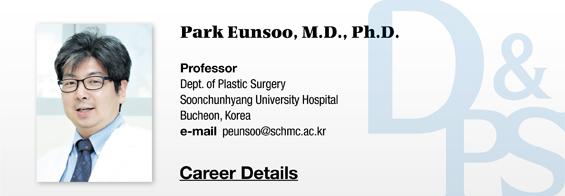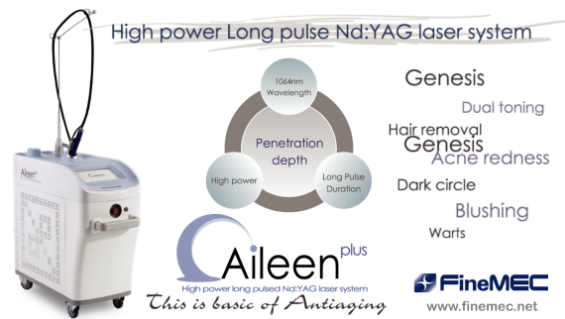Platelet Rich Plasma (PRP) is blood plasma that has been enriched with platelets centrifuged from blood, and is commonly known for PRP injection (blood injection) or autologous blood injection. Plasma contains rich amount of platelets, growth factors required for cell growth, cytokines for cell signaling, and mononuclear cells, which are essential for making stem cells. These components are effective for wound recovery, skin regeneration, anti-aging and treatment of hyperpigmentation, by recovering damaged blood vessels. PRP, when injected in loose and aging skin, is especially helpful for recovering damaged skin and filling up loose skin.
[Advertisement] Aileen plus(Long pulsed Nd:YAG Laser) – Manufacturer: FineMEC(www.finemec.net)
Despite these effects, there is still controversy over the efficacy of PRP, due to unstandardized purification method of PRP, broad variability in the cost of separation devices and kits, unequivalent concentration rate, and lack of objective supporting data.
Among the reports on PRP, the following is a part of an article titled ‘Blood Injection, True or False’ posted in ‘Healthmedi’ on August 25, 2010:
“In the process of centrifugation for PRP, defective device may disrupt the concentration and decrease therapeutic effect or cause inflammatory response, by which the blood is solidified inside the skin. According to the Green Consumer Network in Korea, there have been patients complaining of side effects, such as injection site stiffness or severe swelling, after undergoing blood injection. Furthermore, despite having to use medical centrifuge and vacutainer tube which are validated as not harmful for human body, that’s not the truth. Some clinics were found to have used simple blood sampling kits, which are prohibited for use in vivo.”
Here is another article titled ‘Platelet Rich Plasma (PRP) Therapy’ posted in The Kukmin Daily:
“Early this year, American Academy of Orthopaedic Surgeons reported study results suggesting PRP therapy was effective for tennis elbow among shoulder joint injuries. However, effect on shoulder rotator cuff tear and other shoulder joint injuries were not observed yet. PRP therapy is used for skin care as well as for joints. However, there is not any publication supporting the therapeutic effect of PRP in dermatology. Whether PRP therapy, in any mechanism, is effective for skin whitening and regeneration is unknown, neither long-term safety. It is just known as clinically effective for improving skin condition.”
As you can see from the two articles above, PRP has been attempted in various medical fields for regeneration treatment using growth factors, but there is controversy over its efficacy. There is no established standard for the processes of extraction and concentration of PRP, and the effect may vary depending on individuals. It is worth noting that, around the middle of July, 2012, Medical and Health Insurance Affairs Office of the Korean Medical Association publicized the followings with regard to PRP therapy, in consultation with the Committee for New Health Technology Assessment and Health Insurance Review & Assessment Service in Korea:
❶ The results of new health technology assessment (the 5th committee for new health technology assessment) concluded therapeutic PRP as a ‘technology in investigational stage’, which means it is not recognized as a new health technology, in effect. ❷ Therefore, medical fee reimbursement is applied henceforth, to PRP therapy in the first line healthcare service (including orthopedics, rehabilitation medicine and anesthesiology), when there is a request for confirmation of medical fee from patients. ❸ PRP – for skin care and aesthetic purposes – can be performed under out-of-pocket payment, same as at present, for cases falling to the [Separate Table 2] ‘Non-payment Items’ in the Regulations on the Standard of National Health Insurance Medical Care Benefits; however, medical advertising is not allowed (medical advertising is not allowed for technologies not recognized as a new health technology).
For PRP to be widely applied for therapeutic purposes, more attempts should be made to make PRP recognized as a new health technology, by standardizing a selected preparation and securing the bases of the effect. Recently, the biggest issue in PRP therapy is the application in alopecia treatment. According to a recent article, the University of Brescia in Italy and the Hebrew University Hospital in Israel conducted a clinical trial on PRP therapy and hair growth in 45 patients with areata alopecia. Some patients received PRP injection in the scalp, others topical steroid, and the others placebo (control group), every month. PRP injection group showed significantly greater hair regrowth compared to the steroid group and the placebo group. Although being still in experimental phase, the study suggests the possibility of using PRP injection for the treatment of areata alopecia.
In another study, normal saline was injected on one half of the scalp and PRP on the other half of the scalp, four times at intervals of 1 week, in a 38-year-old male. The hair growth rate increased by approximately 76% on the part where PRP was injected, compared to the part where normal saline was injected. However, there was also a clinical trial reporting no significant effect of PRP therapy in males with genetic alopecia. Further prospective, double-blind studies, under accurate protocol, is needed in this regard.
As mentioned earlier, PRP is defined as autologous plasma containing rich amount of platelet. PRP helps the regeneration and healing process of tissue, by releasing large amount of 7 main growth factors – PDGF-αβ, PDGF-ββ, TGF-β1, TGF-β2, VEGF, EGF and IGF-1 – which are contained in α-granules of platelet. It has been proved that the concentrations of PDGF-αβ and TGF-β1 increase in proportion to the concentration of platelet, which is the basis of clinical use of PRP.
In this process, growth factors are known to stimulate tissues healing, by means of activating cell migration and proliferation, angiogenesis and fibroblast. The tissue healing process was reported to become 2-3 times faster by PRP. PRP is also relatively safe, without the risk of cross reactivity, immune reaction or disease transmission, because it uses autologous blood.
However, not every growth factor increases in proportion to the concentration of platelets. The concentrations of PDGF-ββ, TGF-β2 and IGF-1 were reported as not responding consistently to the concentration of platelets. When platelets are activated, 70% of stored growth factors are released within 10 minutes and more than 95% within 1 hour; therefore, there is a possibility that the effect of growth factors on injured tissue may not work properly. PRP should be prepared under anticoagulation condition and used within 10 minutes from the start of coagulation.
Growth factors play pivotal roles in generation and healing process of tissues, including chemotaxis, proliferation, differentiation and angiogenesis. The role of growth factors have been studied a lot due to such importance in the process of tissue healing.
Growth factors in platelets are mostly contained in α-granules, and PDGF, TGF-β1 and VEGF play particularly important roles in the process of tissue healing. α-granules also contain a cell adhesion molecule called vitronectin, which helps the process of osseointegration and osseoconduction.
PDGF facilitates mesenchymal stem cell replication, osteoid production, endothelial cell replication and collagen synthesis and stimulates the production of other growth factors. PDGF is also the first growth factor present in the damaged tissue area. It is involved in tissue remodeling by stimulating collagen production and protein synthesis. However, a recent animal study reported that PDGF actually inhibits bone growth.
TGF-β1 is activated in the process of inflammation and is known to affect cell migration and proliferation, cell replication and fibronectin bonding activity, stimulate the formation of extracellular matrix, and control the metabolism of osteocytes. VEGF is activated after the process of inflammation and stimulates potent angiogenesis. Anitua et al. reported that VEGF is increases after the release of other growth factors and stimulates the proliferation of tendon cells and the synthesis of type 1 collagen.
As well as PDGF, TGF-β1 and VEGF, bFGF and IGF-1 also play important roles in the process of tissue healing. bFGF affects angiogenesis, cell migration and proliferation, and IGF-1 is known to help fibroblast migration and proliferation and collagen synthesis, mostly in the early phase of inflammation.
Studies in the musculoskeletal field mostly investigated the roles of these growth factors in the process of healing tendon and ligament damages. It has been reported that the recovery of damaged tendons and ligaments is stimulated through gene expression of matrix molecules, proliferation and maturation of tendon cells, angiogenesis, and hypermetabolism.
For the healing process of muscles damage, bFGF and IGF-1 were reported to control myocyte production and muscle regeneration.
For bone union, PDGF works in the early phase, TGF-β in the early and the middle phase, and IGF-1 in the late phase, to stimulate osteocyte differentiation and proliferation.
PDGF, TGF-β and bFGF are reported to be involved in the healing process of cartilage damage. PDGF maintains the property of hyaline and increases the synthesis of proteoglycan, while TGF-β stimulates chondrocyte differentiation and matrix deposition, and bFGF adjusts the metabolism associated with chondrocyte regeneration and inducing cartilage formation, to facilitate cartilage healing.
-To be continued-
▶ Previous Artlcle : #7. Adipose-Derived Stem Cell II – Multipotency
▶ Previous Artlcle : #9-1. Preparation of Platelet-Rich Plasma





















